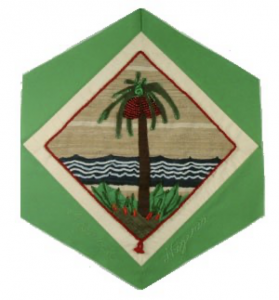Nigeria

The Block
An appliquéd palm tree, standing tall in the centre of this block, represents one of Nigeria’s most useful trees, one that sustains village life in many ways. Rows of bright red beads––typical of those used to decorate traditional clothing––create clusters of ripe palm nuts nestled among the leaves and branches.
Palm oil, which gives many Nigerian dishes their distinctive taste and colour, is extracted from the edible fruit. It is used both locally and for export, in medicine and hand cream, as well as for cooking. The sap is used to make palm wine and distilled alcohol. Fibres from different parts of the tree are made into a variety of items including brooms, hats, mats, and fences. Lush vegetation at the tree’s base is symbolic of the grazing savannah in northern Nigeria, while the hand-woven silk background, hand-dyed by Kofo Dedeke to show the rippling waters of the great Niger River, reflects the country’s strong tradition of strip-weaving.
Cultural Profile
Located on the western section of the continent, bordering the Gulf of Guinea, Nigeria is Africa’s most populous nation—indeed, one in 6 African is Nigerian. The country is also Africa’s largest economy, thanks to its vast oil reserves. Representing only about three percent of Africa’s surface area, the nation contains about 20 percent of the total African population. Nigeria, once a protectorate of Britain, and currently the world’s sixth largest producer and exporter of petroleum, received its name (which refers to the Niger River) from British journalist Flora Shaw who suggested it in the 1890s. The earliest known inhabitants were members of the ancient Nok culture. Today the population is divided into more than 300 ethnic groups, of which the largest are the northern Hausa and Fulani, the southwestern Yoruba, and the southeastern Igbo. English is the official language, although individual ethnic groups speak their own tongue. French is also used along the country’s borders, as it is surrounded by countries who use French as an official language.
The variety of customs, languages and traditions among Nigeria’s numerous ethnic groups give the country a rich and diverse heritage dating back more than 5,000 years. Ancient terracotta sculptures, bronze plaques and statues, ivory carvings, and wooden masks are considered to be Nigeria’s most important artistic legacy. Regional traditions of music and dance, through which Nigerians remember their past and celebrate their present, reflect a culture influenced by African, Islamic and European ways of life.
The development of Nigerian culture has benefited from its large population. Its film industry, nicknamed Nollywood, is the third largest in the world. Nigerian films are popular on the African continent since they address topics that are familiar to many in sub-Saharan Africa, as opposition to American or Indian movies.
Nigeria is renowned for its varied textiles. Indeed, archeological evidence from the 9th century shows that weaving was done in the area of Igbo Ukwu by the Igbo people. Textile traditions include the Yoruba cloth adire, which is dyed with indigo. The patterns in the fabric are obtained either through tie-dye or by painting patterns using starch prior to dyeing. The indigo dyeing pits of Kofar Mata, in Northen Nigeria, established in 1498, are said to be the oldest in Africa. Indigo was also used on the Igbo’s ukara cloth, where resist-dyeing was used to create symbols whose meaning was only known to a chosen few. Traditional embroidery is used extensively on both men’s and women’s clothes, such as the men’s buba long shirt or the fila cap. The machine, European-made embroidered fabric called African lace, made in Austria and Switzerland, is extremely popular in Nigeria. It is part of any formal attire to attend important occasions such as weddings. Silk weaving and silkscreen printing are also practised. The aso oke fabric, woven in strips by the Yoruba men, has also become the word used to describe the dress worn by Nigerian women on special occasions, which feature an elaborate, colourful headdress. The cloth is also used in men’s garments.
Other handicrafts in Nigeria are leatherwork, metalwork, glass beadwork, raffia and grass weavings, and carved calabashes (gourds) created by many skilled artisans.
Nigerian family life includes a strong tradition of mutual caring and responsibility. Relationships are guided by a strict system of seniority, with clearly differentiated gender roles. Traditional social life revolves around rituals, including elaborate infant-naming ceremonies revealing the importance of children within the culture.
Nigerians have been coming to Canada since the 1930s. Early immigrants were technicians and trades people who settled in the larger cities of Ontario, Québec, Nova Scotia, Manitoba, Alberta, and British Columbia. In recent years there has been an increase in the number of people arriving here from Nigeria. They have contributed to many areas of Canadian society, including in the worlds of art and sports. Artist Macaulay Eteli, for example, shares aspects of his native land’s cultural life through his African-inspired paintings, and boxer Dave Defiagbo won the silver medal in boxing for Canada in the 1996 Olympics. As of 2011, there were over 31,000 people of Nigerian ancestry living in Canada.
Sponsor: The Dedeke family
